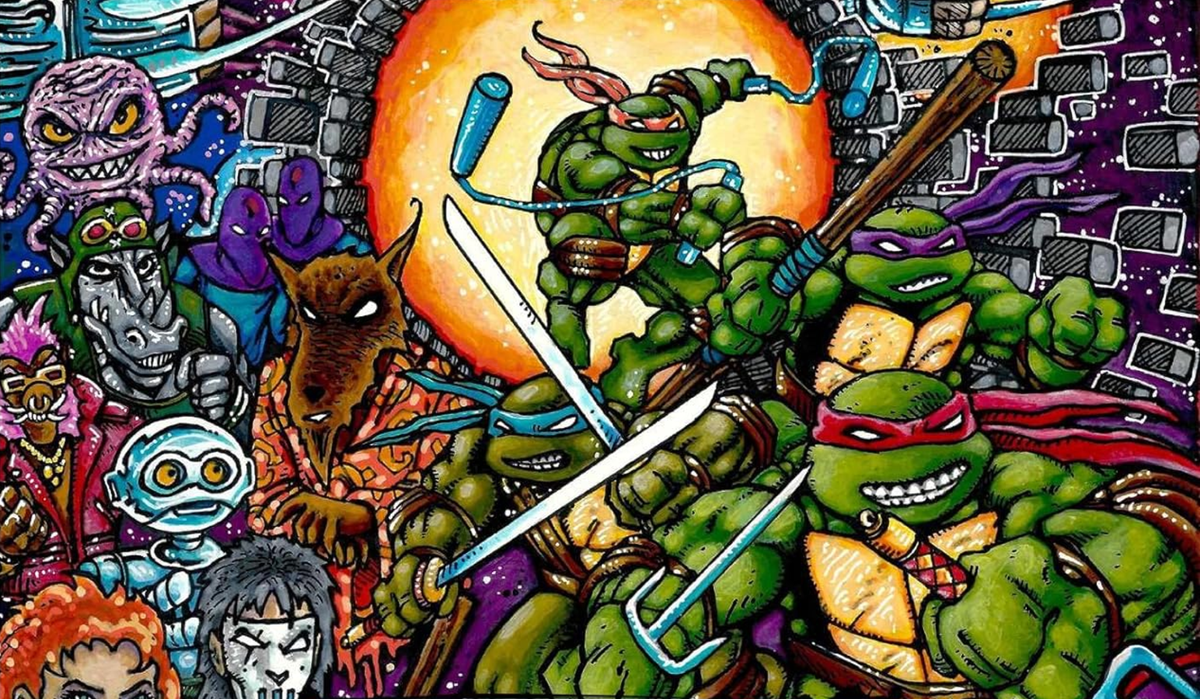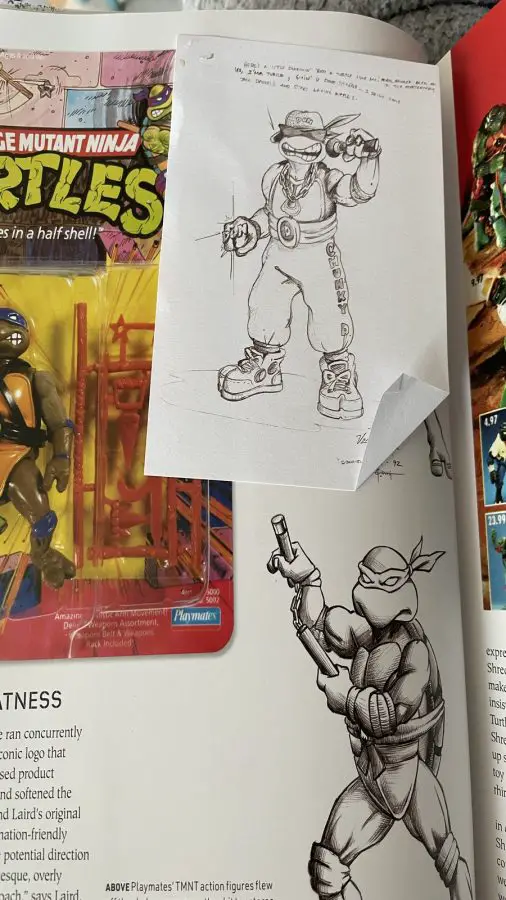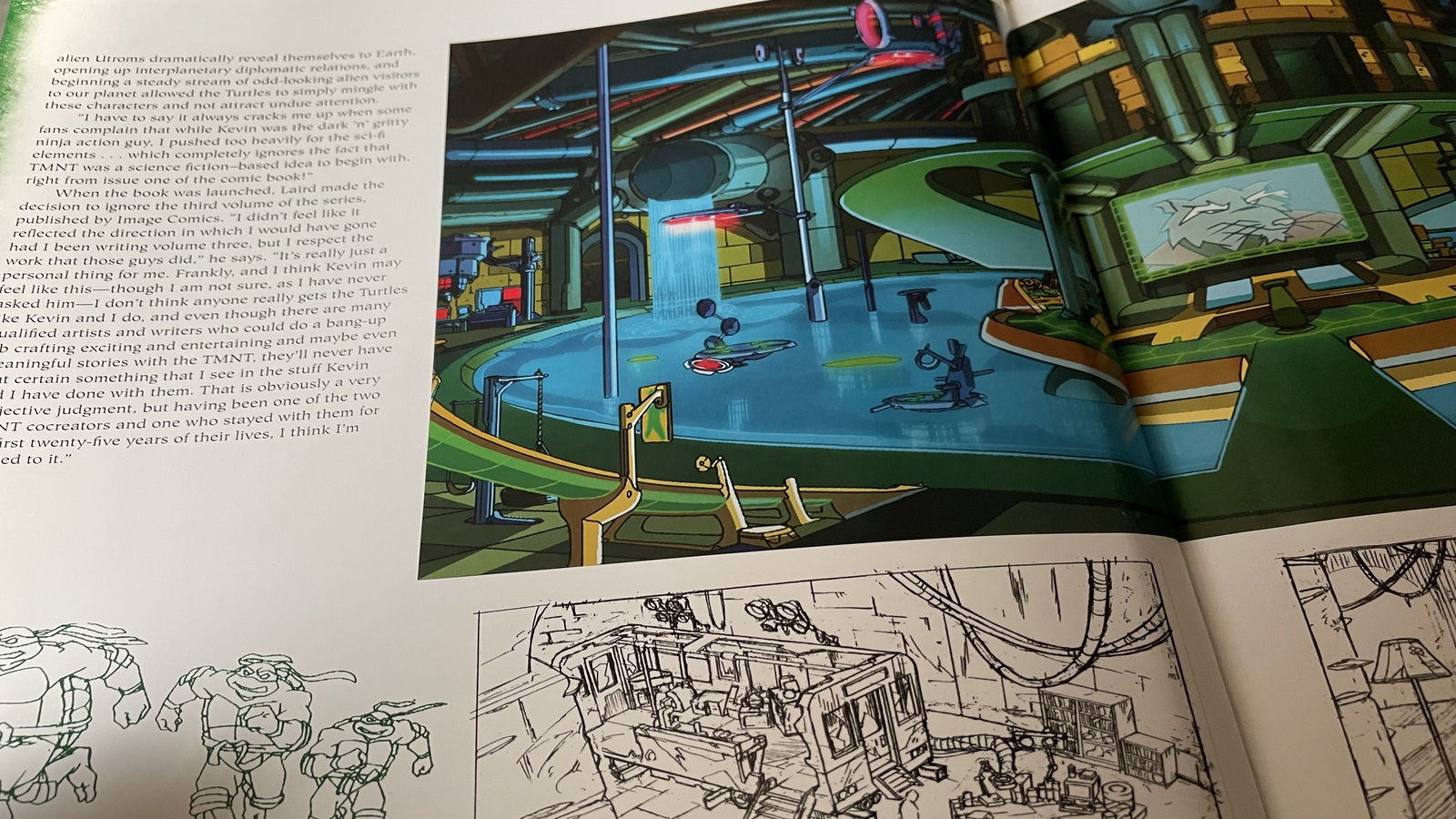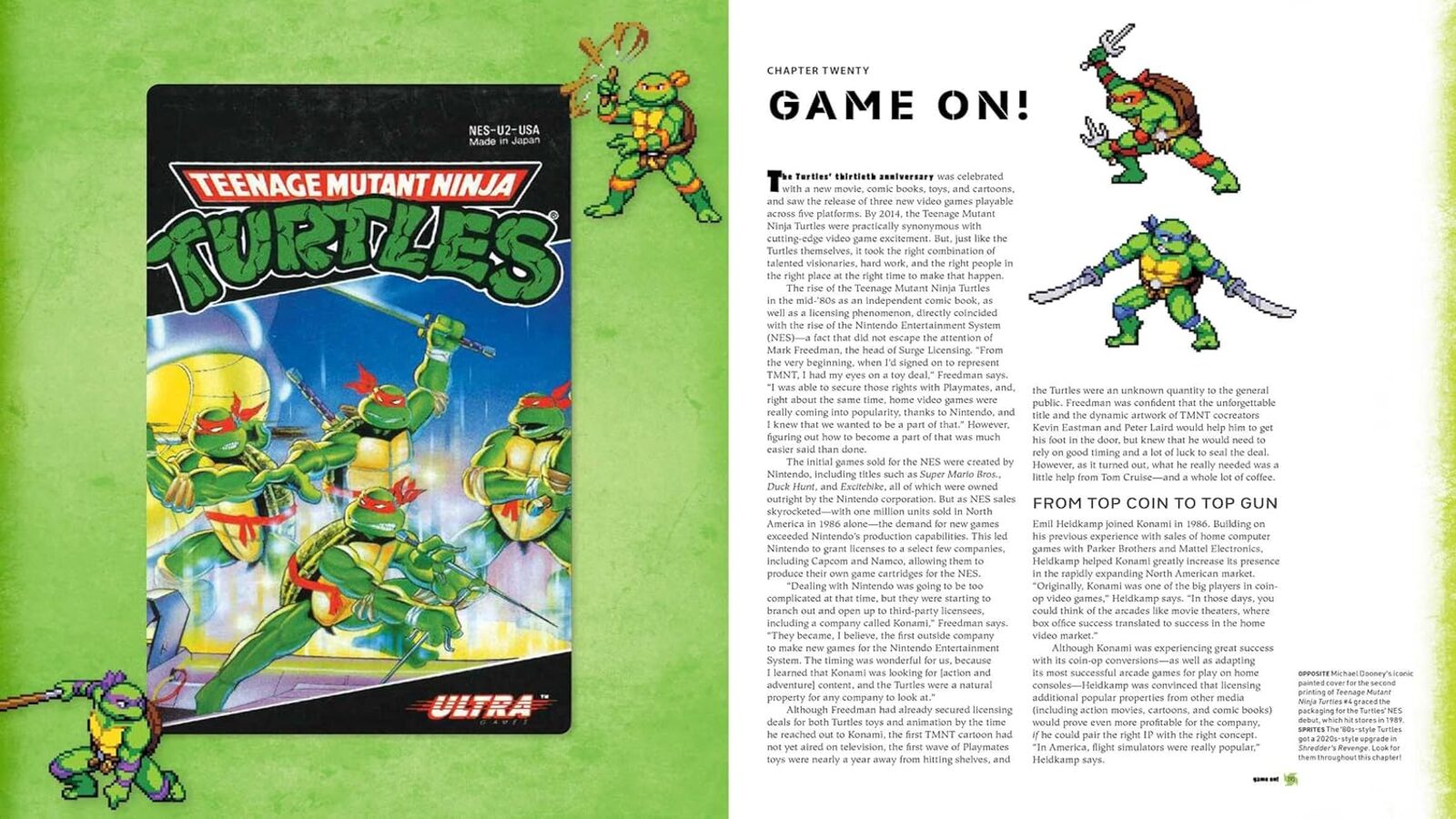
The length and variety of the name “Teenage Mutant Ninja Turtles” can only be matched by their history. Some new incarnation of the TMNT emerges from the sewers every few years, which makes for an interesting evolutionary path to follow. “Teenage Mutant Ninja Turtles: The Ultimate Visual History: Revised and Expanded Edition” aims to do exactly that by chronicling the TMNT from their humble beginnings to their rise to the mainstream and beyond. It contains such a variety of information that you could confuse it for one of those gross pizzas the TMNT like to eat in the cartoon. Like a guacamole, marshmallow, anchovy and hot fudge pizza, there’s a lot to like in this book, but the biggest thing holding it back is that some of its ingredients just don’t go well together.
The TMNT are visual creatures by nature of their comic book origins, and this book captures that aspect faithfully. From its slick hardcover shell featuring a wonderful illustration by TMNT co-creator Kevin Eastman to the barrage of illustrations inside of the book, the whole product looks great. I love Eastman and Laird’s art and it pops on these big pages. Simply flipping through all of the different TMNT incarnations from comics to cartoons to movies conveys their varied history all on its own.
Removable material such as advertisement flyers, comics, and fan club letters accompany the visuals on the pages. The early ads in particular do a great job of conveying the rather humble nature of both the TMNT and independent comic publishing, which draws you into the time period better than traditional pages on a book can accomplish.
While these removable parts add a degree of authenticity to the book, they do come with downsides. For starters, they’re ripe for manufacturing imperfections. The copy I received had one of the removable items come pre-bent and awkwardly smooshed between pages. I also have no real desire to remove these items from the book or store them somewhere separately, as they function more like niche history supplements than anything I’d have a use for outside of the book.
Extensive written word supplements the book’s visual flourishes to provide a chronological overview of the TMNT’s progression. Most of the narrative gets told via direct quotes and insight from the people involved with each era of the brand, particularly TMNT creators Peter Laird and Kevin Eastman. Given the TMNT’s conception as a small project that grew far bigger than anyone expected, the focus on people feels apt.
I expect most TMNT diehards will already know most of the stories and anecdotes littered throughout the book, but that doesn’t make them less fun to follow. The writing flows well and moves between topics at a steady pace. The book generally hits all of the pertinent beats and then some – I particularly appreciated the spotlight shone on some of the stranger periods of TMNT like the edgy Image comics and ill-fated Saban era of the late 90s. I wish the author printed some of Laird’s harsher comments about Venus, the ill-fated 5th turtle, because his hatred of the concept is so amusing, but his modern comments still convey the gist of his feelings.
Originally published in 2014, the initial printing of the book could obviously only go so far down memory lane. Plenty has happened in the world of TMNT in the decade since then, and this new printing makes the most of it with large sections dedicated to new material like The Last Ronin, Mutant Mayhem, the latter half of the IDW comics, and more. These sections often feel more extensive than the earlier material, likely due to being able to cover them in closer proximity to their creation.
Structurally, the book consists of 28 chapters that mix the written words with relevant images. Initially, it tells the story from a more holistic perspective, but as the TMNT projects begin to grow in number, the focus of each chapter narrows to focus on them individually. I found the setup worked best when focused on individual projects, as the layout of the book can get strange when multiple have to share the spotlight.
As an example, once the story hits the early 2000s, it starts off by talking about the fourth volume of the TMNT comic book series. For whatever reason, it accompanies the text about the comic with images from the 2003 TMNT cartoon. I’m a big fan of the 2003 show so I appreciate any acknowledgement it gets, I just wish it was acknowledged in the appropriate places. This odd mismatch doesn’t give this era of the comic its due, and that’s not the only place this happens. A far more egregious mismatch appears in this Ultimate History’s coverage of TMNT video games, which to put it as politely as I can, is a bizarre section of the book.
When I think of TMNT video games, I think of Konami’s beat-em-ups. I suspect that’s the case for most people. They’re basically the definitive depiction of the TMNT in gaming and played a pivotal role in defining how comic books tend to be adapted in the medium. Yet if you take a look at this book, you wouldn’t get that impression, as virtually every page discussing them is accompanied by images from the 2022 game Shredder’s Revenge. This decision comes across like the author either wants to imply Konami made Shredder’s Revenge or that Shredder’s Revenge is “close enough,” which feels like a huge disservice to the subjects being discussed.
The strange treatment of Konami’s TMNT doesn’t end there. Perhaps I’m biased, but I think you can say a lot about how Konami interpreted the TMNT on both a visual and mechanical level. After all, this was a cross-cultural collaboration that helped define people’s understanding of and affection for the TMNT. Yet despite this, you won’t find any in-depth discussion of these games or even any direct insight from anyone actually involved in their creation.
Instead, you get superficial overviews from indirect sources like business people and a “video game historian.” The detached nature of this chapter stands in stark contrast to the detailed information and creative insight provided in the rest of the book. When the “video game historian” characterizes something as being an “easy decision” for Konami, it would be nice to know what information he’s basing that statement on, or if he had any real insight into Konami’s business decisions at all when he said it!
Coverage of Konami’s return to the TMNT brand in the early 2000s proves even more anemic, to the point that it borders on misinformation. If you were to go off of the information in this book, you’d likely think that the main product of this era was a Gameboy Advance game rather than the fully 3D games that home consoles received but are not mentioned in any capacity. Further, you’d think that the GBA game received sequels directly built on its foundation, rather than sequels in name only that are essentially entirely different games.
The video game section almost feels as though the author included it out of obligation rather than out of any having any genuine passion or insight into the subject matter. I get that to an extent – obviously the comics are the most important part of TMNT history followed by the cartoons. In the grand scheme of TMNT, the video games don’t play as much of a vital role. I’m also sure it’s much harder to track down former Konami employees to talk to than Eastman and Laird. Still, I can’t help but be dissatisfied with how such an important part of their history got treated and I’d say it’s the book’s major black mark.
Of course, it’s not all bad. New to this edition are specific chapters covering Shredder’s Revenge and The Cowabunga collection individually. Each chapter features appropriate images and input from people that actually created the games. However, these additions do put this book in an awkward position where it has far more to say about a collection of Konami’s TMNT and a game directly inspired by Konami’s TMNT than Konami’s TMNT itself. I know I’m harping on this a lot but this is a GAMINGTrend review, so I’ll harp on game coverage as much as I want!
Taken as a whole, however, this Ultimate Visual History drives home that we’re entering an interesting era for the TMNT. Eastman and Laird told their “last” TMNT story with The Last Ronin and Laird appears to be checked out from involvement with it as a whole, while Eastman’s involvement seems limited to occasional comics. TMNT as a whole is now being driven forward with virtually no oversight from its creators. To paraphrase Laird in the book, no one quite “gets” TMNT like its creators do. That won’t stop anyone from making more TMNT anyway, which inevitably means the TMNT we get from this point onward will gradually grow more and more removed from what it once was.
In a way, then, the current incarnation of this Ultimate Visual History serves as the perfect capstone for TMNT history as it stands. Some odd omissions in detail aside, it provides a nice and comprehensive overview of TMNT from the beginning to end as envisioned by its original team, with a presumably long and unknown future ahead to be told by other people. It’s an interesting history told in a pleasant package. And at the end of the day, even if some of the ingredients are strange, pizza is pizza.
Good
Teenage Mutant Ninja Turtles: The Ultimate Visual History: Revised and Expanded Edition, as the name suggests, provides an expansive overview of just about everything TMNT. While the video game coverage lacks the same attention to detail, it’s otherwise filled with personal insight from TMNT’s creators and amazing illustrations that gives a nice dip into every aspect of the brand.
Pros
- Great presentation
- Lots of insight from creatives
Cons
- Poor video game coverage
- Some mismatches between text and visuals



